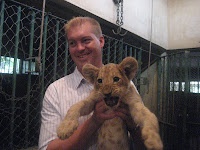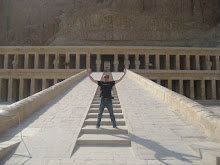Hello!
I am happy to report that I'm settled in Abuja, and have completed my first week of work. I hope I did not worry anyone for not writing right away. With the jet lag and starting work a week ago last Monday, I'm just now able to collect my thoughts.
I arrived to Abuja last Saturday after a 21 hour transit from DC to Abuja, Nigeria via Addis Ababa, Ethiopia. I flew on Ethiopian Airlines, and to be honest it is tied for the blue ribbon award for the best international flight that I've taken to date, a brand new Boeing 777 with more food and drinks than I knew what to do with. Half the plane was empty so I easily had three seats to sleep on. I only had a two hour layover in Ethiopia, but everyone, was amazing and friendly and I hope to return there for an extended weekend or more. Ethiopian Air is deemed the best African Airline and just joined the Star Alliance.
Upon touchdown in Abuja, I couldn't help but notice the airport is very small, rustic and outdated. I've found that there are hardly any flights in and out and if you were to search for flights online, most travel sites will not even recognize the airport code (ABV). For it being the capital airport of the richest African country, myself and even the Nigerians themselves are deeply disappointed they don't have a modern airport. Soon enough I believe though.
So far, Abuja is great, at least for those living the expat life like me. As bad as it is, as I hate to say it, compounded further that I know real and severe poverty and suffering occurs not far from where I am. Life for me and many foreigners here is more than comfortable. In fact, the expats are bored and if I stay long enough, I'm sure I will be too. My accommodations are superb, with a huge room, private bathroom, gated compound with 24 hour security and most important, a clean pool. I'm very fortunate that my company takes care of its employees well being.
My work here is inspiring. The Nigerian Customs Service has launched for the first time, and initiative to modernize is procedures and practices in order to clamp down internal corruption and third party price gauging to collect more revenue for the Nigeria government. This in turn, despite the severe corruption that does exist here, will help the infrastructure immensely. The economy is growing at 5+% this year, as there are construction projects abound. Much like Washington, DC. the skyline is full of cranes building new structures. I give Abuja a decade on things will be much further developed.
I am happy to report that I'm settled in Abuja, and have completed my first week of work. I hope I did not worry anyone for not writing right away. With the jet lag and starting work a week ago last Monday, I'm just now able to collect my thoughts.
I arrived to Abuja last Saturday after a 21 hour transit from DC to Abuja, Nigeria via Addis Ababa, Ethiopia. I flew on Ethiopian Airlines, and to be honest it is tied for the blue ribbon award for the best international flight that I've taken to date, a brand new Boeing 777 with more food and drinks than I knew what to do with. Half the plane was empty so I easily had three seats to sleep on. I only had a two hour layover in Ethiopia, but everyone, was amazing and friendly and I hope to return there for an extended weekend or more. Ethiopian Air is deemed the best African Airline and just joined the Star Alliance.
Upon touchdown in Abuja, I couldn't help but notice the airport is very small, rustic and outdated. I've found that there are hardly any flights in and out and if you were to search for flights online, most travel sites will not even recognize the airport code (ABV). For it being the capital airport of the richest African country, myself and even the Nigerians themselves are deeply disappointed they don't have a modern airport. Soon enough I believe though.
So far, Abuja is great, at least for those living the expat life like me. As bad as it is, as I hate to say it, compounded further that I know real and severe poverty and suffering occurs not far from where I am. Life for me and many foreigners here is more than comfortable. In fact, the expats are bored and if I stay long enough, I'm sure I will be too. My accommodations are superb, with a huge room, private bathroom, gated compound with 24 hour security and most important, a clean pool. I'm very fortunate that my company takes care of its employees well being.
As for safety, the area if very calm and tranquil. People are friendly and inviting on a personal level. However, it is standard that when it comes to anything relating to money, anyone living here know that a trick is in store. Despite what you all may here on the news, where I'm at is safe. Trust me.
My work here is inspiring. The Nigerian Customs Service has launched for the first time, and initiative to modernize is procedures and practices in order to clamp down internal corruption and third party price gauging to collect more revenue for the Nigeria government. This in turn, despite the severe corruption that does exist here, will help the infrastructure immensely. The economy is growing at 5+% this year, as there are construction projects abound. Much like Washington, DC. the skyline is full of cranes building new structures. I give Abuja a decade on things will be much further developed.
More stories to come, but all is safe and well here.
-Mike















